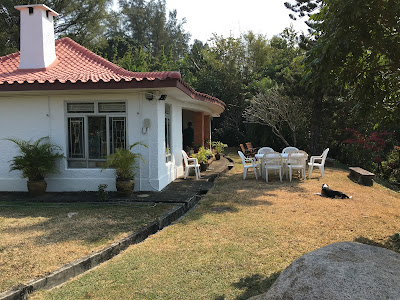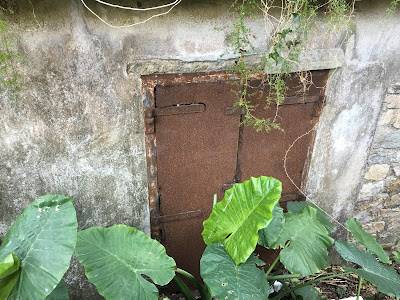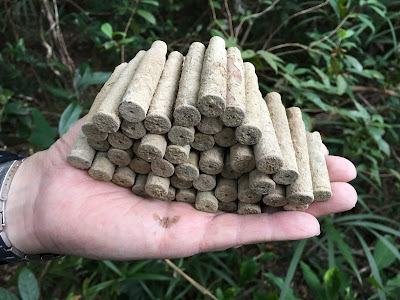Captain Eric Philip Wiseman, RASC On 7th February, I was delighted to receive a copy Hong Kong: Recollections of a British Prisoner of War published by Veterans Publications in Canada (2001) and written by former Captain E. P. Wiseman, RASC. Eric Philip Wiseman, always known as Bill Wiseman, was born in December 1917 in Kuala Lumpur. He attended Kings School Canterbury, and whilst there and whilst "fooling around on a train," he was involved in an accident that resulted in the loss of a foot. Notwithstanding this he was a able to join the Territorial Army as 2nd Lt in the RASC. He was mobilised in 1939 following the outbreak of war in Europe. In 1940 he was posted overseas to 12 Coy RASC, China Command, Hong Kong.
When war started in Hong Kong on Monday 8th December it was Wiseman's 24th Birthday. He was responsible for the Vehicle Collection Centre (VCC) at Happy Valley. Two days after the Japanese landings he was ordered to relocate the Transport Pool to Sassoon Road, Pokfulam. Here he was shot in his un-amputated leg by friendly fire. There is a reference to his being wounded in the RASC war diary.
"During this night of heavy rain (20th/21st December), fire from Tommy Guns of Indian units on Sassoon (Road) was sporadic especially on the occasion that a visit to Miramare�s telephone was necessary and in the house itself Capt Wiseman was wounded". (Source: Lt Howell, RASC War Diary).
 |
| Cover of Bill Wiseman's book (Veterans Publications, 2001) |
 |
| Captain Bill Wiseman (from the book) |
Wiseman's book contains an account of his experiences during hostilities and subsequently as a POW. It has interesting bio details on some of his fellow POWs including Major Boxer and Lt-Cdr Boldero. It also has some interesting sketches including one of the gallant gunboat HMS
Cicala. This warship was in the thick of action until she was sunk in the East Lamma Channel. She was small but powerful, her armament consisted of two 6-inch guns (forward and aft), a 3-inch high angle gun and a 2-pdr pom-pom AA gun. She was commanded by Lt-Cdr. John Boldero who had served at the Battle of Jutland in WW1 and had left the Royal Navy during post war down-sizing. He was recalled for service in September 1939 on the outbreak of war in Europe. He lost his right arm during a collision between an MTB and
Cicala. Here's a pre-war photograph of
Cicala in dry dock.
 |
| HMS Cicala in dry dock (Writer's Collection) |
Another interesting sketch was of WDV
French. This launch was one of the WD (War Department) vessels operated by the RASC, under the blue ensign.
French was used in the evacuation of troops from Devil's Peak Peninsula and throughout the period of hostilities.
 |
| A fine looking launch - WDV French (From Bill Wiseman's Book) |
After being wounded, Bill Wiseman was admitted to the nearby Queen Mary Hospital. In the next bed was Major Charles Boxer, the Head of the combined forces intelligence unit. Boxer, a Japanese linguist, was well known to the Japanese from his liaison role with the Japanese Army. He received visitors from senior Japanese officers who were impressed when Major Boxer introduced Captain Wiseman and implied that he had lost one leg and been wounded in the other during the fighting. Impressing the Japanese officers and one can almost imagine the sucked-in breath and the "so desu-ka."
Stanley Internment Camp Notes
From Bill Wiseman's book I discovered that Captain John ("Jack") Gordon Whitaker Adjutant of 5th AA Regiment, Royal Artillery, had married Wendy Winnifred Willcocks in Hong Kong shortly before the war. He was held in military POW camps and she was incarcerated in Stanley Camp with her parents Major James Lugard Willcocks and Muriel Kathleen Willcocks. A quick search of old Hong Kong newspapers revealed that the marriage between Jack Whittaker and Wendy Willcocks took place at St John's Cathedral on 25th October 1939. A reception was held at the Hong Kong Club Annex and the honeymoon was in less than exotic Fan Ling. H.E. the Governor was represented at the wedding by his Aide-de-Camp Captain Sydney Batty-Smith. Batty-Smith died in February 1945 whilst interned at Stanley Camp.
Major Willcocks was born in India the son of an Indian Army officer. Major Willcocks had served with the Black Watch in WW1 during which he was awarded the DSO and MC. He married Muriel Price in 1916. Their daughter Wendy was born in Bermuda in 1919. She was 22 years old when she was interned at Stanley Camp. Major Willcocks was serving as Commissioner of Prisons in 1941 and was a member of the HKVDC. He commanded the Stanley Force and was the right hand man for Brigadier Wallis in the Battle for Stanley.
Bill Wiseman also mentions Lt. Michael H. Turner who was married to fifty-three-year-old Daisy Turner who was incarcerated in Stanley Camp with her married daughter Beryl Daisy Skipwith (nee Turner). They shared a room in the Indian Quarters with Joyce Bassett. Bill Wiseman writes that Lt Turner was known as "Pop" in POW Camp on account of his age (thought to be around 55). He had been the Head of prominent law firm Deacons before the war and the family had lived in a villa at Skek-O. He had been called to serve as a 2nd Lt in the 5th AA Regiment, Royal Artillery in 1941. His daughter Beryl Daisy had married Captain Patrick Skipwith, Adjutant of 8th Coast Regiment based at Stanley Fort.
Joyce Bassett had been a secretary working for the Colonial Secretariat. She had been based at Government House during hostilities. Her widowed mother Florence Eva Thornhill was also in Stanley Camp. Her bother Sub-Lt John Thornhill was serving with HKRNVR and was incarcerated in POW camp.
War Walk with HK ClubOn Saturday 11th February in delightfully cool and sunny weather I took a group of twenty members of HK Club on a guided battlefield tour of WNC Gap area. We started at the Stanley Gap 3.7-inch Howitzer Battery and finished at a pillbox above Blacks Link (PB 3). PB 3 was not manned when the Japanese stormed WNC Gap early in the morning on Friday 19th December. The crew from Winnipeg Grenadiers were proceeding up to gap to man the PB when they found Japanese troops in possession of the area around the police station knoll. PB 3 is still in good condition. The machine gun mountings and swivels can still be seen. Sadly the inner walls have been vandalised and daubed with red paint and graffiti.
 |
| Battlefield tour (courtesy Mark Peaker) |
 |
| Inside PB 3 at Blacks Link |
Bungalow 'C' at St Stephen's College, Stanley
On Sunday 12th February I had lunch at Bungalow 3 at St Stephen's College. It used to be called Bungalow 'C' or simply as Barton's Bungalow taking the name of the pre-war family occupants. Today it is the home of the College Chaplain. There used to be six of these bungalows. Today five remain. They were originally built as staff bungalows. St Stephen's College was once known as the Eton of the East. One of the bungalows (Bungalow 'A') has been converted into a heritage museum. All these bungalows have a war history and especially Bungalow 'C'.
During the Battle for Stanley the area was held by members of the HKVDC and the Mx Regt. As the fighting grew close some of the troops took up positions inside the bungalow. The Japanese used a flame thrower killing many of the defenders. One or two survived although suffering from burns and were not spotted by the Japanese who took possession of the the three bungalows (A, B and C). By this time the Main School building (used as a temporary military hospital) had been occupied by the Japanese. A large number of patients, orderlies and nurses were killed when the Japanese broke in. Many patients were bayoneted in their beds. Three of the European nurses were raped, mutilated and killed. All this on Christmas Day. Later that morning 'D' Coy Royal Rifles of Canada attacked the ridge where the three bungalows were located. They attacked across the nearby military cemetery and briefly reoccupied the bungalows before being driven out by Japanese reinforcements.
After the British surrender the grounds of St Stephen's College were used to accommodate civilian internees. As many as fifty men, women and children were crowded into each of the the bungalows. On 16th January 1945 Bungalow 'C' was accidentally bombed by an American aircraft and fourteen internees were killed and a large number wounded. Today it is beautiful and peaceful spot, the bungalow has shrugged off its tragic past, and has a pleasant ambience with beautiful views across the bay and the surrounding hills.
 |
| Bungalow C |
Retracing the route taken by CSM Hamlen, RASC, with Peter WeedonOn 15th February I joined Peter Weedon, a Facebook friend and military history enthusiast, for a 'war walk' around the battlefields and military ruins at WNC Gap, and thereafter we followed part of the route taken by CSM Frederick Hamlen, RASC, from the Deep Water Bay RASC depot to the RAOC depot at the Ridge, his escape to a house called Overbays following an ambush, and his capture at Eucliffe. Many of the troops captured around Repulse Bay, who had attempted to reach Repulse Bay Hotel during the night of 22nd/23rd December, were put to death in the grounds of Eucliffe.
CSM Fred Hamlen was tied up and made to kneel on the grass slopes facing Repulse Bay together with three other Canadian soldiers with whom he had been captured. A firing party came out from the house and shot them. However Hamlen turned as he was shot and the bullet entered his neck and exited through his face and he survived. He rolled down the hill and the bodies of the other soldiers landed around and on top of him. He recalled that one died instantly and the other two must have bled to death. After the fighting ended more than fifty bodies of British and Canadian troops were found at the bottom of the slope, all having been shot or bayoneted. Hamlen escaped along the foreshore in the direction of Deep Water Bay, where he joined Major Young and a group from 'A' Coy Royal Rifles who escaped by boat and made their way to the beached destroyer
HMS Thracian on nearby Round Island. They used the destroyer's Carley Floats to reach Lamma Island and were captured after the British capitulation after having landed in Telegraph Bay on Hong Kong Island. Hamlen survived the war, and later gave evidence at war crimes trials held in Hong Kong after the war. He remained in the Army and retired as a Major in 1962. He passed away aged 81 in 1991 fifty years after his close brush with death.
 |
| Peter Weedon entering PB 1 through the machine gun aperture |
 |
| The bunker at Stanley Gap which served as QM Stores for HKVDC No. 3 Coy |
 |
| Inside the QM Stores at Stanley Gap |
 |
| Light AA position on top of the Command Centre (Battery HQ) Stanley Gap AA Battery |
 |
| At West Brigade HQ Shelters |
Major Edward (Ted) de Vere Hunt I did some research on Major Edward de Vere Hunt. I knew of him and his role as commanding officer of 1st Mountain Battery and I knew that he had been killed in action at WNC Gap on 19/20th December 1941. The research into his family, his schooling, his military career, his sporting success and his marriage to Nancy made it all the more personal.
 |
| Major Edward de Were Hunt, HKSRA |
I published a short post about him on 14th February. He died as he lived his life, utterly fearless, a strong leader, admired and respected by all. You can read the story by clicking the link below:
Major Edward William Francis de Vere Hunt - Killed in action 20th December 1941battleforhongkong.blogspot.hkOn the Battlefields - Stanley MoundOn Saturday 18th February, I met history enthusiast Stuart Woods on Chung Hom Kok Road near the site of West Bay AA Battery. The battery splinter proof shelters still remain, but have been lived in for many years by a family who run a garden nursery. There are a string of four or five of these war shelters as seen in the photograph below. They are on the south side of a mound and on the north side are a ring of several more war shelters that were destroyed long ago to prevent illegal squatting.
 |
| West Bay AA Battery war shelters now being used as a garden centre |
We struggled up Stanley Mound with our metal detectors and were later joined by Craig Mitchell. Apart from shrapnel I found nothing and went back leaving Stuart and Craig detecting around the crest of Stanley Mound, There had been fighting on Stanley Mound and the hilltop had changed hands twice. After I left, Stuart found a Japanese artillery shell case (75mm) and a Japanese mess can set (see below).
 |
| Japanese mess cans (Courtesy Stuart Woods) |
On the Battlefields - Tai Tam X-RoadsOn Tuesday 21st February I went with Stuart Woods to check out the ruins of a house known as
Cash's Bungalow located on a mound immediately north-west of the Tai Tam X-Roads. Japanese troops occupied this house around 21st December 1941 and at least one machine gun located at this bungalow was firing at Canadian troops (Royal Rifles of Canada) and detachments from HKVDC as they seized the high ground of Notting Hill and Bridge Hill, and as East Infantry Brigade advanced towards the Tai Tam X-Roads. Fighting also took place around Red Hill and close to another villa called
Erinville. In the ruins of
Cash's Bungalow we found the machine gun position as evidenced by dozens of Japanese spent 7.7mm machine gun spent rounds. We found the position close to the remains of a garden wall which would have provided some protection for the machine gun crew.
 |
| Spent 7.7mm machine gun rounds found at Cash's Bungalow |
I updated an old blog I had written about these two houses
Erinville and
Cash's Bungalow. It tells the story of who lived there and what happened around these two villas in December 1941. Join me for a walk through history in the Battle of Hong Kong by clicking the link below.
erinville-and-cashs-bungalow-at-redhill.html |
| Stuart on what was the drive running up to Cash's Bungalow |
Stanley Gap 3.7" AA BatteryPeter Weedon posted on the
Facebook Battle of Hong Kong site a copy of a Japanese artist's rendition of the capture of the two 3.7-inch AA Guns at Stanley Gap (near Wong Nai Chung Gap). I labelled it to show the crest of Jardines Lookout, the battery accommodation shelters and the Command Post (also referred to as Battery HQ).
 |
| Labelled version to show orientation |
 |
| Post-war Aerial photo showing location of AA Battery relative to WNC Gap |
The AA battery was overrun and captured early on Friday 19th December 1941 by Colonel Shoji's 230th Infantry Regiment, who had landed at North Point the previous evening, and advanced from Braemar reservoir along the track known as Sir Cecil's Ride, which they followed to Wong Nai Chung Gap in an anticlockwise direction around Jardines Lookout.
.................................





















0 komentar:
Post a Comment
Note: Only a member of this blog may post a comment.